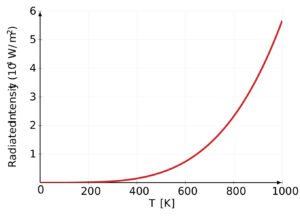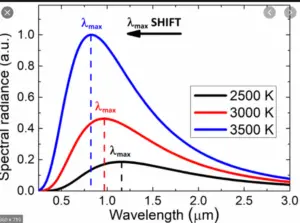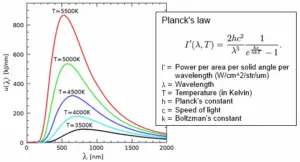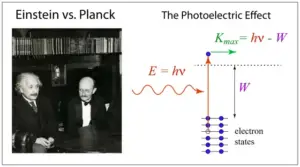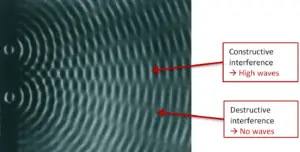Have you ever wondered about the different types of light and energy that surround us, like visible light, radio waves, and X-rays? Well, scientists have been curious about these too for a long time! They tried to understand if these forms of energy were like waves or tiny particles.
In the early 1900s, they discovered something amazing. These energies behave in both ways! They can act like waves and particles at the same time. This fascinating idea is called “wave-particle duality.”
To explain this dual behavior, scientists introduced a new concept: “photons.” Photons are like tiny packets of energy that make up electromagnetic radiation, which is all these different types of light and energy we experience.
In this article, we’ll explore the world of photons and how they have revolutionized our understanding of the universe. We’ll see how they can behave as waves and particles, and how they interact with matter, leading to cool things like the photoelectric effect and X-ray machines.
The knowledge of photons has also led to incredible technological advances, like quantum computing and medical imaging. But there are still some exciting mysteries to solve, like the role of photons in quantum gravity and the possibility of dark photons.
So, let’s get ready to discover the tiny yet powerful world of photons and their incredible impact on our lives and our understanding of the universe!
Early Experiments and Wave-Particle Duality
Back in the late 1800s and early 1900s, scientists were puzzled by the behavior of electromagnetic radiation, such as light. They conducted experiments that couldn’t be explained by traditional ideas of waves alone. These experiments set the stage for a groundbreaking concept: wave-particle duality.
One of the first mysteries was the study of blackbody radiation by a scientist named Max Planck. When he looked at how hot objects emit light, classical wave theories failed to explain the results. To make sense of the data, Planck proposed that energy is emitted and absorbed in tiny, discrete amounts, or “quanta.” This was a big departure from the idea that energy was continuously spread out like a wave.
Later on, Albert Einstein came along and made another huge contribution. He tackled the photoelectric effect, where light shining on certain materials causes them to emit electrons. According to wave theories, the brighter the light, the more energy should be given to the electrons, and they would be emitted no matter what. But that’s not what the experiments showed. Einstein proposed that light comes in tiny particles, now known as photons. These photons carry specific amounts of energy and can knock electrons out of materials, perfectly explaining the photoelectric effect.
These two experiments laid the foundation for the wave-particle duality concept. Electromagnetic radiation, like light, could act as both waves and particles, depending on the circumstances of the experiment. It was a mind-bending idea that challenged our conventional understanding of physics.
Read Also
- Uncertainty in measurement chemistry, class 11 NCERT
- Laws of chemical combination: chemistry class 11, NCERT
- John dalton’s atomic theory: postulates & limitations, class 11, NCERT
Introducing Photons: Nature and Properties
Now that we’ve learned about the early experiments that paved the way for the wave-particle duality concept, let’s delve deeper into the fascinating world of photons – the tiny packets of energy that make up electromagnetic radiation.
What are Photons?
Photons are the smallest, indivisible units of electromagnetic radiation. They are like little bundles of energy, and each photon carries a specific amount of energy depending on its frequency.

Key Characteristics of Photons
- Zero Mass: Unlike particles we encounter in our everyday lives, photons are massless. They zip through space at the fastest speed possible – the speed of light, which is about 299,792 kilometers per second (186,282 miles per second).
- Absence of Electric Charge: Photons do not carry any electric charge. They are electrically neutral, making them different from particles like protons and electrons, which have positive and negative charges, respectively.
- Energy-Frequency Relationship: The energy of a photon is directly related to its frequency. This relationship was first proposed by Max Planck and later explained by Albert Einstein. The higher the frequency of a photon, the more energy it carries. This concept is mathematically expressed as E = hf, where E is the energy of the photon, h is Planck’s constant (approximately $6.626 \times 10^{-34}$ joule-seconds), and f is the frequency of the photon.
Wave-Particle Duality of Photons
One of the most mind-boggling aspects of photons is their dual nature. As we discussed earlier, photons can behave both as waves and particles. When photons are observed in certain experiments, they display wave-like behaviors, such as interference and diffraction patterns. In other experiments, they behaved like particles, interacting with matter as discrete entities.
This duality is not unique to photons alone but is a fundamental property of all particles in the quantum world. The wave-like and particle-like behaviors of photons are two sides of the same coin, reflecting the profound mysteries and complexities of the quantum realm.
Understanding the nature and properties of photons has been crucial to the development of quantum mechanics and our understanding of the subatomic world. This knowledge has paved the way for groundbreaking technologies like lasers, solar cells, and fiber-optic communication, which rely on harnessing the unique properties of photons. As we continue our journey through the world of quantum physics, we will see how these tiny packets of energy play a central role in shaping the universe as we know it.
Interactions of Photons with Matter
Photons, as the carriers of electromagnetic radiation, play a crucial role in how light and energy interact with matter. When photons encounter different materials, fascinating interactions occur, which have significant implications in various fields of science and technology.
The Concept of Quantized Energy Transfer
The idea that energy is transferred in discrete packets (quanta) by photons rather than in a continuous manner is central to understanding their interactions with matter. This concept was initially introduced by Max Planck and is a cornerstone of quantum mechanics.
Read Also:
- Maxwell’s equations class 12: integral form, differential form, applications, and explanation
- Displacement current class 12: definition, modification, formula, and properties
- Electromagnetic waves class 12: definition, equation, graphical representation, and applications
- Electromagnetic spectrum class 12
The Photoelectric Effect
The photoelectric effect, first explained by Albert Einstein, demonstrates one of the most remarkable interactions between photons and matter. When photons with sufficient energy strike the surface of a material, they can transfer their energy to the material’s electrons. This causes electrons to be emitted from the material, creating an electric current.

What’s astonishing is that for the photoelectric effect to occur, the energy of the incident photons must exceed a specific threshold value, regardless of their intensity (brightness). This phenomenon supported the particle nature of photons and was critical in validating Einstein’s idea that light can behave as discrete particles.
The photoelectric effect is not only of fundamental importance in quantum mechanics but also has practical applications, such as in solar cells, where it is harnessed to convert light energy into electricity.
Compton Scattering
Compton scattering is another intriguing interaction between photons and matter. When photons collide with electrons in a material, they can be deflected, changing their direction and losing some of their energy in the process.
The phenomenon was first observed by Arthur Compton, who confirmed the particle-like behavior of photons. The degree of deflection and energy loss depends on the angle and energy of the incident photon and the properties of the material’s electrons.

Compton scattering has significant implications in fields such as X-ray imaging, where it is used to generate detailed images of the internal structures of objects.
Understanding these interactions between photons and matter has been instrumental in the development of technologies like X-ray machines, lasers used in various applications, and optical fibers that enable high-speed data transmission. Moreover, the insights gained from studying photon-matter interactions have deepened our understanding of quantum mechanics and its role in the behavior of matter and energy at the atomic and subatomic levels. As we continue to explore the quantum world, the importance of photons in shaping the fabric of our reality becomes increasingly apparent.
Photon Detection and Measurement
Detecting and measuring photons is essential for studying and harnessing their unique properties in various scientific and technological applications. Scientists have developed specialized methods and instruments to detect individual photons and precisely measure their characteristics.
Methods of Detecting Photons
- Photomultiplier Tubes (PMTs): Photomultiplier tubes are sensitive photon detectors widely used in scientific research and industrial applications. When a photon strikes the photocathode of a PMT, it releases electrons through the photoelectric effect. These electrons are then accelerated and multiplied through a series of dynodes, resulting in a detectable electrical signal.
- Photodiodes: Photodiodes are semiconductor-based devices that convert incoming photons into an electric current. When a photon strikes the semiconductor material, it creates electron-hole pairs, generating a measurable current. Photodiodes are commonly used in cameras, solar cells, and fiber-optic communication systems.
- Charge-Coupled Devices (CCDs): CCDs are electronic devices used in digital imaging. When photons strike the surface of a CCD, they generate electron-hole pairs, creating an electric charge that is converted into a digital image by the device.
- Single-Photon Avalanche Diodes (SPADs): SPADs are highly sensitive detectors capable of detecting single photons. They work on the principle of avalanche breakdown, where a single photon triggers a chain reaction of electron multiplication, resulting in a measurable electrical pulse.
Quantum Efficiency and Sensitivity of Detectors
- Quantum Efficiency: Quantum efficiency is a measure of how well a detector can convert incoming photons into detectable electrical signals. A higher quantum efficiency means that the detector can capture a greater percentage of incident photons, making it more sensitive.
- Sensitivity: The sensitivity of a photon detector refers to its ability to detect low levels of light or weak signals. Detectors with high sensitivity can detect even a single photon, enabling applications in quantum optics, quantum cryptography, and low-light imaging.
Applications of Photon Detection
Photon detection finds application in numerous fields, including:
- Astronomy and Astrophysics: Detecting photons from distant celestial objects helps astronomers study the universe and gather information about stars, galaxies, and cosmic events.
- Quantum Information Processing: Quantum computing and quantum cryptography heavily rely on the detection of individual photons to perform complex calculations and secure communications.
- Medical Imaging: Photon detectors, such as those in X-ray machines and positron emission tomography (PET) scanners, aid in non-invasive medical imaging, diagnosis, and treatment.
- Communication: Photon detectors are essential in fiber-optic communication systems, enabling the transmission of data over long distances at high speeds.
Photon detection and measurement have significantly advanced our understanding of the quantum nature of light and paved the way for cutting-edge technologies that rely on harnessing the power of individual photons. As research continues in this exciting area, we can expect even more breakthroughs that will impact various aspects of our lives and further our knowledge of the quantum world.
Read Also
- AC circuit containing an inductor only
- AC circuit containing resistor only, class 12
- Representation of AC current and voltage by phasor diagram
- AC circuit containing resistor and inductor in series
Quantum Electrodynamics (QED)
Quantum Electrodynamics, often abbreviated as QED, is a branch of theoretical physics that deals with the interactions between photons (electromagnetic radiation) and charged particles, such as electrons and positrons. It is one of the most successful and accurate theories in physics, describing the behavior of these particles and their associated electromagnetic fields within the framework of quantum mechanics.

The Birth of Quantum Electrodynamics
- Development of Quantum Mechanics: The birth of quantum mechanics in the early 20th century revolutionized our understanding of the subatomic world. Scientists like Max Planck, Niels Bohr, and Werner Heisenberg developed a new mathematical framework to describe the behavior of particles at the quantum level.
- Dirac’s Equation: In 1928, Paul Dirac formulated a relativistic quantum mechanical equation to describe electrons. His equation successfully combined the principles of quantum mechanics and special relativity and predicted the existence of antiparticles, such as the positron (the antimatter counterpart of the electron).
- Birth of QED: The theory of quantum electrodynamics was born as a result of efforts to extend Dirac’s equation to include the interaction of electrons with electromagnetic fields, specifically photons. This led to a comprehensive understanding of how charged particles interact with light.
Description of QED
- Feynman Diagrams: QED employs Feynman diagrams, a powerful graphical tool, to represent particle interactions mathematically. These diagrams provide a visual representation of the various processes involving photons and charged particles.
- Photon Exchange: In QED, charged particles interact by exchanging virtual photons. These virtual photons are intermediary particles that carry the electromagnetic force between charged particles, leading to attractive or repulsive interactions.
- Renormalization: QED calculations involve infinities that need to be accounted for and eliminated to provide meaningful results. Richard Feynman, Julian Schwinger, and Tomonaga Shinichiro independently developed a technique called “renormalization” to handle these infinities and obtain finite and physically meaningful results.
Successes and Predictive Power of QED
- Anomalous Magnetic Dipole Moment: QED accurately predicts the magnetic dipole moment of electrons and other charged particles, a measurable property related to their magnetic behavior.
- Lamb Shift: QED successfully explains the Lamb shift, a tiny but significant energy shift observed in the electron orbits of hydrogen atoms.
- Precision Tests: QED predictions have been extensively tested and verified through precision experiments, making it one of the most rigorously confirmed theories in physics.
Limitations and Beyond
- Electroweak Theory: While QED describes the electromagnetic force, it is only part of a larger picture. The electroweak theory unifies the electromagnetic force with the weak nuclear force, providing a more comprehensive understanding of particle interactions.
- Quantum Gravity: QED does not include gravity, and thus, it is not applicable in the realm of general relativity. Scientists are actively working on developing a theory of quantum gravity to reconcile gravity with quantum mechanics.
Quantum Electrodynamics stands as a monumental achievement in theoretical physics, providing a solid foundation for understanding the electromagnetic interactions of charged particles. Its success has inspired the development of other quantum field theories, shaping our understanding of fundamental forces and the behavior of particles at the smallest scales of the universe. As researchers continue to explore the mysteries of the quantum world, QED remains an indispensable tool in our quest for a more complete understanding of the cosmos.
Applications of Understanding Photon Behavior
The understanding of photon behavior, both as particles and waves, has revolutionized various scientific and technological fields. Harnessing the unique properties of photons has led to a plethora of applications that impact our daily lives and push the boundaries of modern science.
Quantum Computing and Information Processing
- Quantum Bits (Qubits): Photons can be used as qubits, the fundamental units of information in quantum computing. Their ability to exist in multiple states simultaneously, known as superposition, allows quantum computers to perform complex calculations much faster than classical computers.
- Quantum Communication: Photons enable secure communication using quantum key distribution (QKD). QKD ensures that any attempted eavesdropping on quantum communication is immediately detectable, making it highly secure for transmitting sensitive data.
Optoelectronics and Photonics Technologies
- Lasers: Lasers, based on the stimulated emission of photons, have a wide range of applications, from industrial cutting and welding to medical treatments and telecommunications. They produce intense and coherent light, making them indispensable tools in various fields.
- Fiber-Optic Communication: Photons are used to carry information through optical fibers in the form of light pulses. Fiber-optic communication enables high-speed data transmission over long distances, forming the backbone of the modern internet.
- Photonic Sensors: Photonic sensors utilize the interaction of photons with materials to measure various physical properties, such as temperature, pressure, and chemical composition. They are vital in environmental monitoring, medical diagnostics, and industrial automation.
Medical Imaging and Radiation Therapy
- X-ray Imaging: X-rays, which are high-energy photons, are widely used in medical imaging to visualize bones and internal structures. They are invaluable tools in diagnosing various medical conditions.
- Positron Emission Tomography (PET): PET scanners use photons emitted during the annihilation of positrons (antielectrons) with electrons to create detailed images of biological processes in the body. PET is employed in cancer diagnosis and monitoring.
Quantum Entanglement and Quantum Cryptography

- Quantum Entanglement: Photons can be entangled, a phenomenon where the properties of two or more particles become intertwined, regardless of distance. This unique feature is used in quantum teleportation and quantum communication protocols.
- Quantum Cryptography: Photons’ ability to transmit information securely, thanks to the laws of quantum mechanics, forms the basis of quantum cryptography. It promises unbreakable encryption methods for secure communication and data protection.
Read Also:
- Rutherford atomic model: postulates, observations, and limitations, class 11
- Thomson model of atom: postulates, drawbacks, & significance, class 11
- Cathode Tube Ray Experiment class 11: working, procedure, observation, and conclusion
- Discovery of Electron class 11: chemistry, NCERT
- Discovery of proton class 11: chemistry NCERT
- Exploring the Bohr Atomic Model: A Comprehensive Guide
- Wave nature of electromagnetic radiation, class 11
Solar Energy Technologies
Photons from the Sun are harnessed in solar cells to generate electricity. Photons striking semiconductor materials in solar panels release electrons, creating an electric current that can power homes, buildings, and electronic devices.
The applications of understanding photon behavior are vast and continually expanding. From revolutionizing computing and communication to improving healthcare and energy sustainability, photons are at the core of numerous technologies that shape our modern world. As researchers continue to explore the quantum world and develop new ways to manipulate photons, we can expect even more exciting and transformative advancements in the future.
Challenges and Unsolved Mysteries
While our understanding of photons and their behavior has led to incredible advancements, there are still intriguing challenges and unsolved mysteries that continue to captivate scientists and drive research in the world of quantum physics.
Quantum Gravity and the Role of Photons

- Unifying Quantum Mechanics and General Relativity: One of the most significant challenges in modern physics is the unification of quantum mechanics, which governs the behavior of photons and other subatomic particles, with general relativity, the theory of gravity. Quantum gravity aims to explain the behavior of gravity at the quantum level, but achieving this union remains an open question.
- The Nature of Gravitons: Photons are associated with electromagnetic force, but what about the force of gravity? The hypothetical particle responsible for carrying the gravitational force is called a graviton. However, the existence and properties of gravitons remain unconfirmed, making the study of quantum gravity a complex endeavor.
Photon Entanglement and its Implications
- Non-Locality: Entangled photons exhibit a unique connection known as “non-locality.” When two entangled photons are separated by vast distances and the state of one is changed, the other instantaneously responds, regardless of the distance between them. This behavior challenges our understanding of causality and the traditional concept of locality in physics.
- Quantum Information and Communication: The phenomenon of entanglement holds immense promise for quantum information processing and quantum communication. However, harnessing entanglement for practical applications remains a challenging task, especially when dealing with decoherence, which causes the delicate quantum states to lose coherence in real-world conditions.
Dark Photons and Their Hypothetical Existence

- Dark Matter and Dark Energy: The composition of the universe remains elusive, with dark matter and dark energy accounting for the majority of its mass-energy content. While photons interact with regular matter through electromagnetism, the existence of “dark photons” is proposed as carriers of a new type of force that interacts with dark matter.
- Detecting Dark Photons: Detecting and studying dark photons is a significant challenge since they are thought to interact weakly with ordinary matter and light. Researchers are actively exploring novel experimental approaches to shed light on this mysterious aspect of the cosmos.
Fundamental Constants and Fine Structure Constants
- The Fine Structure Constant (α): The fine structure constant, denoted by α (alpha), is a dimensionless constant that characterizes the strength of the electromagnetic force between charged particles. While its value is known with extraordinary precision, the underlying reasons for its specific value remain an enigma, raising questions about the nature of fundamental constants.
Quantum Decoherence and Measurement Problem
- The Quantum Measurement Problem: The nature of quantum measurements and the collapse of the wave function continue to spark debates and philosophical discussions. Understanding the process of measurement and its connection to the broader quantum world remains an open question.
- Quantum Decoherence: The phenomenon of quantum decoherence describes the interaction of quantum systems with their environment, leading to the loss of quantum coherence. This process poses challenges for maintaining and controlling delicate quantum states, which are essential for quantum technologies.
As we venture further into the realm of quantum physics, these challenges and unsolved mysteries highlight the fascinating depths of our universe. Exploring the nature of photons and their role in quantum phenomena is fundamental to addressing these questions and unveiling the hidden truths that shape the very fabric of reality. The quest to comprehend these mysteries continues to drive scientific exploration and shape our understanding of the quantum world.
Stay tuned with Laws Of Nature for more useful and interesting content.



